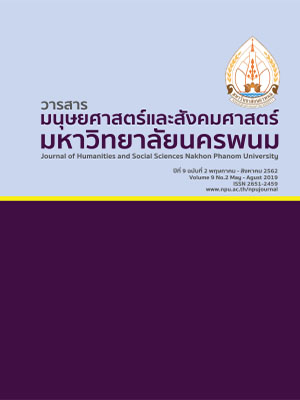Spiritual Leadership of Rajabhat University Administrators In The Northeastern : Mixed Methods Research
Main Article Content
Abstract
The purpose of this research were 1) to study the spiritual leadership indicators of Rajabhat University administrators in the northeastern 2) to test the goodness of fit for the spiritual leadership model of Rajabhat University administrators in the northeastern with empirical data. The implementation of the research had divided into 2 periods; the first period was a study of spiritual leadership indicators
of Rajabhat University administrators in the northeastern from the synthesis of related documents and
the interviews of 3 experts. The research had analyzed the qualitative information and evaluated
the appropriateness of components and indicators. Then this research has formulated a draft of measurement model. The second period was the checking of the congruence in spiritual leadership model of Rajabhat University administrators in the northeastern with empirical data by studying from
a group of academic personnel, support staffs and the student leaders in Rajabhat University in
the northeastern in the number of 480 people. The data-collecting instruments were the interview and the set of five-leveled questionnaires and the reliability was 0.98. The data analyzing was statistical computer program by M-plus Statistics for consideration the components and checking the congruence
of the improved indicator measurement model with empirical data.
The result showed that: 1) the spiritual leadership of Rajabhat University administrators in the northeastern had 5 components, 18 sub-components and 71 indicators which consisted of (1) the main components of vision which had 3 sub-components and 13 indicators (2) the main components of hope and faith which had 4 sub-components and 18 indicators (3) the main components of love and desire for others which had 4 sub-components and 17 indicators (4) the main components of spiritual which had
4 sub-components and 16 indicators and (5) the main components of self-awareness which had
3 sub-components and 9 indicators. 2) the indicator measurement model of spiritual leadership
of Rajabhat University administrators in the northeastern was congruent with empirical data including
chi-square = 108.083 at degree of freedom = 87, and P-Value = 0.0625. In addition, the RMSEA and SRMR were 0.022, and 0.026 respectively. Moreover, the CFI and TLI were 0.997, and 0.995 respectively
Article Details
References
ยุทธศาสตร์ โยธะพล. (2557). การพัฒนาตัวบ่งชี้ภาวะผู้นำเชิงจิตวิญญาณของผู้บริหารสถานศึกษา สังกัดองค์การบริหารส่วนจังหวัดในภาคตะวันออกเฉียงเหนือ. วิทยานิพนธ์ปริญญาดุษฎีบัณฑิต. เลย : มหาวิทยาลัยราชภัฏเลย.
รัตติกรณ์ จงวิศาล. (2556). ภาวะผู้นำ ทฤษฎี การวิจัย และแนวทางสู่การพัฒนา. พิมพ์ครั้งที่ 2. กรงเทพฯ : จุฬาลงกรณ์มหาวิทยาลัย.
สำนักงานคณะกรรมการการอุดมศึกษา. (2560). กรอบแผนอุดมศึกษาระยะยาว 15 ปี ฉบับที่ 2 (พ.ศ. 2551–2565).
สืบค้นเมื่อ 20 ตุลาคม 2560 ; จาก http://www.mua.go.th.
สุทธิพงษ์ ทะกอง และพระครูสุจริยวัฒน์. (2561). ตัวบ่งชี้ภาวะผู้นำเชิงคุณธรรมสำหรับผู้บริหารสถานศึกษาขั้นพื้นฐาน:โมแดลความสัมพันธ์เชิงโครงสร้าง. วารสารมหาวิทยาลัยนครพนม. 8 (1), 49-58.
สุนันท์ ฝอยหิรัญ สุรัตน์ ไชยชมภู และธนวิน ทองแพง. (2559). การศึกษาปัจจัยการบริหารที่ส่งผลต่อความผูกพันที่ส่งผลต่อความผูกพันของครูในโรงเรียนประถมศึกษา สังกัดสำนักงานเขตพื้นที่การศึกษาประถมศึกษาสระแก้ว เขต 2. วารสารมหาวิทยาลัยนครพนม. 6(2), 43-51.
Hair,et al. (2010). Multivariate data analysis. (7thed.). New Jersey : Pearson Education.
Norman,J. (2016). The Influence of Spiritual leadership on Employees and Organizations : A Multiple case study. University of Phoenix. United States of America.


